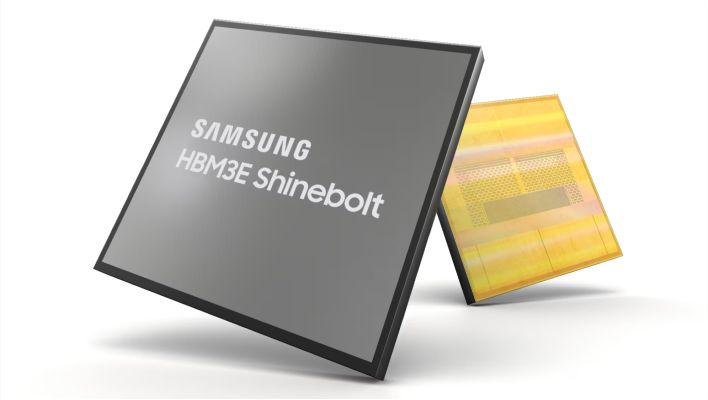[ad_1]
Samsung has divulged some updates on its subsequent era reminiscence merchandise—together with GDDR7 reminiscence—at its annual Reminiscence Tech Day in San Jose. Alongside GDDR7, Samsung introduced its Shinebolt HBM3E reminiscence, which is being developed for upcoming AI and compute GPUs.
GDDR7 reminiscence has been in growth for a while. It is set to seem in subsequent era Blackwell RTX 50-series and RDNA 4 RX 8000-series graphics playing cards. Samsung did not disclose too many particulars, however one of the crucial fascinating little nuggets was the reveal of a goal of fifty% much less stand-by energy. That’ll assist to scale back total idle energy consumption, and hopefully decrease it for multi-monitor setups and video playback too.
GDDR7 reminiscence is ready to function at 1.2V in comparison with the 1.35v working voltage of GDDR6 and GDDR6X. Assuming we see excessive speeds of as much as 32Gbps as predicted, a complete bandwidth of 1TB/s is feasible over a 256-bit bus. Within the case of a 384-bit bus, that bandwidth would improve by an extra 50%.
Samsung beforehand disclosed that its GDDR7 reminiscence will make the most of PAM3 (pulse-amplitude modulation) signaling versus GDDR6X’s PAM4. Whereas PAM4 is best suited to larger frequencies, PAM3 is less complicated to implement, making it a greater choice for inexpensive client graphics playing cards. That partly explains why we have by no means seen inexpensive GDDR6X playing cards, though sooner reminiscence could be helpful when contemplating the comparatively skinny reminiscence buses of present era mid-range GPUs.
PAM3 delivers decrease common bit-error charges, however given the upper inherent efficiency supplied by GDDR7, PAM4 is seen because the preferable choice for now. After all, that leaves the door open to a future GDDR7X normal. Is that one thing Micron might need up its sleeve? We’ll have to attend and see. A hypothetical RTX 5090 Ti with a 512-bit bus and GDDR7X would lead to a bandwidth score of above 2TB/s. That sounds tasty certainly, although the value of such a card could be extreme, to place it mildly.
Given the place we’re on the present launch cycle, GDDR7 geared up playing cards are certainly a 12 months away at greatest. I would anticipate it to be restricted to excessive finish playing cards. Subsequent gen entry stage playing cards are very prone to stick to GDDR6, a minimum of till manufacturing actually ramps up and it turns into value efficient sufficient to contemplate.

Samsung additionally talked about its subsequent era HBM3E reminiscence. Whereas we might love HBM3E reminiscence to be included in gaming graphics playing cards, its expense and complexity guidelines it out. Samsung says its Shinebolt reminiscence can hit as much as 9.8Gb/s per pin which might give a single HBM3E stack 1.225GB/s of bandwidth. That is a lot larger than the 819Gb/s supplied by HBM3.
In the event you add a number of stacks, these numbers skyrocket. In response to numbers sourced from our sister web site Anandtech, a flagship GPU might theoretically include 216GB of reminiscence with an astonishing 7.35TB/s of bandwidth. A reference RTX 4090 delivers a hardly sluggish 1,008GB/s compared.
Samsung has not mentioned whether it is mass producing GDDR7 but, which is not shocking given there’s a minimum of a 12 months to go earlier than GDDR7 playing cards are launched. However it’s good to see that it is speaking freely about it at this stage, which factors in direction of a mature normal that is readily in a position to hit the market in quantity when subsequent era playing cards do arrive.
[ad_2]
Source link


